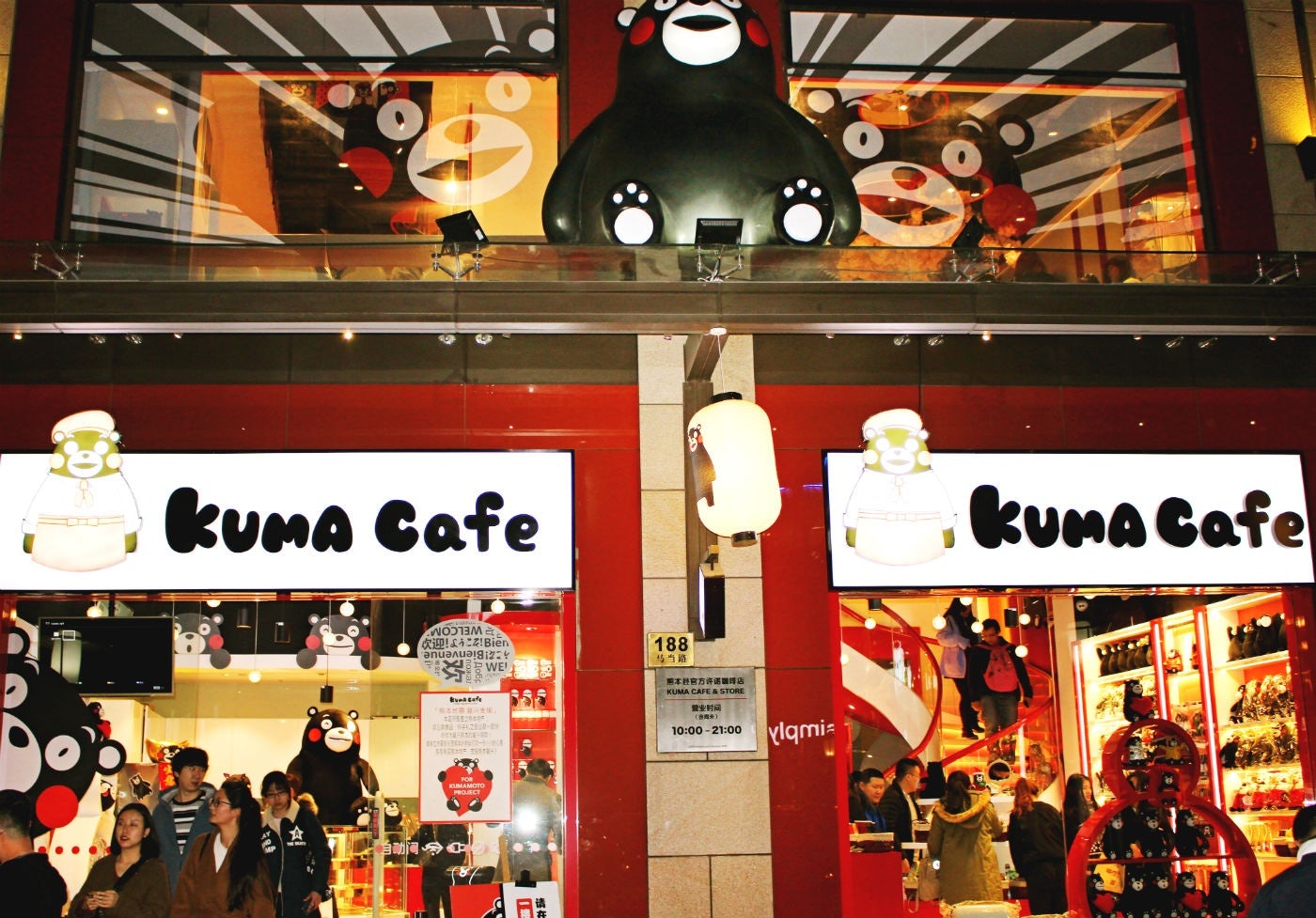More Chinese travelers are heading to Japan independently on cultural explorations, but one Japanese city is aiming to bring Japan to them.
In Shanghai's trendy, upscale Xintiandi, the two-story Kuma Cafe is bringing in packs of selfie-taking fans of a certain rosy-cheeked black bear called Kumamon that has taken the Chinese internet by storm. The space, which opened in January, was an instant hit among millennials, with a two-hour long queue just to get in.
The first floor is split into two areas: a counter to order coffee and desserts, such as the Kuma hot spring shortcake (a chocolate Kumamon bear "bathing" in blue coconut cream with coconut icing doubling as "steam"), and a souvenir area where Kumamon's kawaii face is on every single product, from luggage, to sushi vinegar, to pillows and stuffed animals. On the second floor, customers can take photos with a huge Kumamon, while a television screen shows images of Kumamon's hometown to promote tourism to the area.
Kumamon was created by the Kumamoto prefecture in southwestern Japan in 2010 to promote local tourism and produce. The cartoon bear surged in popularity with the help of local government marketing campaigns—one staged event saw Kumamon accompanying the governor on a business trip to Osaka, where Kumamon was captivated by the allure of the big city and 'got lost,' resulting in the governor holding a press conference, calling on people to search for Kumamon. Kumamon became "Japan's Most Popular Bear," bringing US$1.2 billion in annual sales to his previously poor town.
Kumamon's success in Japan quickly spread. Chinese online memes, or biaoqing, featuring cute Kumamon imagery spread on social media, so much so that the brand is taking a chance that Chinese millennials will flock to "meet" the character in a real life setting. Aside from hoping to stir an interest in tourism to Kumamoto, Kuma Cafe has set ambitious annual sales goals of 18 million RMB (US$2.61 million) from coffee and desserts and 240 million RMB (US$34.88 million) from merchandise.
The café positions itself in an area targeted at Shanghai's affluent shoppers and charges about US$10 for a palm-sized dessert. Most of the merchandise available is in the more affordable range, but the character has been known to attract major collaborations for pricier products in Japan: German toy brand Steiff created plush toys of the bear in 2013 for US$300, and in 2015, Leica made a Kumamon camera for US$3,300. Whether the Japanese cartoon will become popular enough in China to create a market for these more high-end products is uncertain, but the lukewarm response to the café so far suggests there is work to be done.
Within over two months of being open, Chinese consumer opinion site Dianping has accumulated numerous complaints about Kuma Cafe, from the mediocre taste of coffee and desserts, to the lack of product variety and unfriendly service. Many customers on Dianping said they were disappointed that after queuing for two hours, there was nothing much to see in the café, which they felt was crowded and small.
Other themed cafes in China have had similar fates in the past. In 2012, a Hello Kitty Cafe opened in Beijing to damning CNN reviews. Then, of course, there are the ubiquitous knockoffs. Shanghai's Line Cafe, an eatery and store featuring animated characters from the popular Japanese messaging app (which is banned in China), has performed better than most since its opening in 2015 according to Dianping reviews, with four out of five stars.
There are signs that consumers are willing to pay more for these pop culture characters if experiences are well-executed. A recent Wall Street Journal article reports that there are more consumers in China's emerging middle class who are willing to spend more money for licensed merchandise from their favorite film and TV characters as opposed to counterfeit items. This is indicated by the success story thus far of The Simpsons store, which opened its first outlet in Beijing's upscale Taikoo Li shopping mall and has since spread to other areas in China. And unlike in the U.S., where these products attract mainly children, it's China's millennials collecting merchandise from animated franchises, like Angry Birds and Disney, according to the article.
Kumamon may have had humble beginnings, but it might need to work harder to impress increasingly discerning young Chinese consumers with spending power. If Shanghai Disney Resort is anything to go by, an opportunity to capture this market is no doubt emerging.
